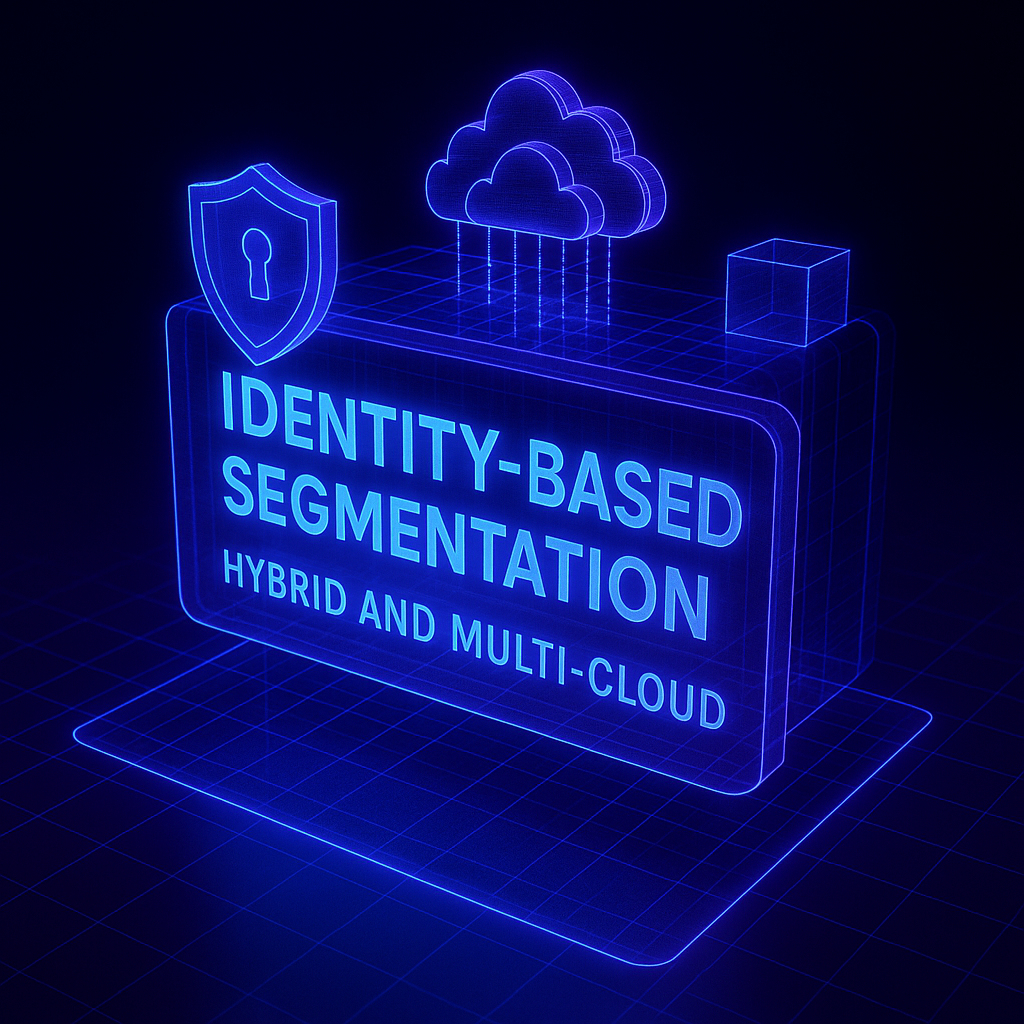The promise of cloud computing was always agility — workloads that scale on demand, services that integrate seamlessly, and global reach. But agility comes at a cost: complexity.
Key challenges that make static models fail:
- Ephemeral IPs: Every time a container spins up, it gets a new IP. Static ACLs can’t keep up.
- Cross-cloud drift: AWS Security Groups, Azure NSGs, and GCP Firewalls all work differently. Trying to enforce one consistent policy across them is nearly impossible.
- East-west traffic: Most traffic today moves between workloads inside clouds, not in and out. Traditional firewalls, built for north-south inspection, miss it entirely.
This is why organizations are shifting from network-based controls to identity-based models. In dynamic environments, the comparison between Identity-Based Segmentation vs. Network Segmentation is stark: the former adapts and scales across clouds, while the latter was built for static, on-premises networks.
Core Principles of Identity-Based Segmentation
At its core, identity-based segmentation is about shifting the unit of trust. Instead of tying trust to an IP address or subnet, policies follow identities — workloads, devices, or users.
Principles:
- Granularity: Each application or workload sits in its own microsegment.
- Least Privilege: Only explicitly defined communications are allowed.
- Context-awareness: Policies consider workload labels like env=prod, tier=db, or owner=finance.
- Portability: Because policies are identity-driven, they work across data centers, public cloud, and SaaS.
Identity-based segmentation is effectively the modern evolution of microsegmentation. While microsegmentation initially described breaking networks into smaller zones, the identity-driven approach ensures those zones adapt dynamically to cloud-native realities.
NIST SP 800-207 and Zero Trust Alignment
Zero Trust has become the north star for enterprise security, and NIST SP 800-207 is its playbook. The standard states clearly: no network location should ever be trusted by default. Every request must be continuously verified, and access must follow least-privilege principles.
Microsegmentation — especially identity-driven — is one of the core ways to make this real. It enforces rules so that only authenticated, authorized identities can communicate, regardless of where they run.
This ties directly into ZTNA (Zero Trust Network Access). While ZTNA governs user-to-application access, identity-based segmentation governs workload-to-workload flows. Together, they cover both humans and machines, creating a holistic Zero Trust environment.
Architecture of Identity-Based Segmentation in Hybrid/Multi-Cloud
To implement segmentation in hybrid environments, organizations typically rely on a layered model:
- Control Plane: A central policy engine that integrates with IAM, tags, and service identity providers. It defines intent: “Payroll app can talk to Payroll DB.”
- Data Planes: Enforcement points across environments.
- Agents on workloads (VMs, containers).
- Service Mesh in Kubernetes clusters, with sidecars and mTLS.
- SDN/Overlays in private data centers.
- Cloud-native tools like SGs, NSGs, or cloud firewalls.
- Agents on workloads (VMs, containers).
This layered model is often referred to as Next-Gen Microsegmentation, because it blends multiple enforcement techniques into a unified architecture. Instead of being tied to one technology, policies are identity-driven and applied consistently across all layers.
Agent-Based Microsegmentation in Hybrid Environments
One of the most common enforcement approaches is Agent-Based Microsegmentation.
Here’s how it works:
- Small agents are deployed directly on workloads.
- They observe traffic flows, enforce deny-by-default policies, and tie enforcement to workload attributes.
- They provide telemetry to central controllers for monitoring and analytics.
Pros:
- Granular, context-aware enforcement.
- Works across clouds and on-prem.
- Strong visibility into workload behavior.
Cons:
- Requires deployment and lifecycle management of agents.
- May introduce slight performance overhead if not tuned properly.
For many enterprises, agent-based approaches provide the practical bridge between legacy infrastructure and modern, multi-cloud environments.
Implementation Lifecycle
Identity-based segmentation isn’t a “big bang” project — it’s a lifecycle.
- Discover: Map traffic flows between workloads and services.
- Label: Tag workloads with meaningful attributes (env, app, tier, owner).
- Simulate: Test policies in monitor-only mode to validate without disruption.
- Enforce: Apply deny-by-default, creating true microsegments.
- Monitor & Adapt: Continuously refine based on telemetry and changing workloads.
This lifecycle ensures segmentation becomes part of operations, not a one-off project. It also shows how microsegmentation works best when integrated with automation and CI/CD pipelines.
Use Cases Across Hybrid and Multi-Cloud
Common scenarios include:
- Regulatory Compliance: Isolating PCI or HIPAA workloads to reduce audit scope.
- Ransomware Containment: Stopping lateral movement across workloads.
- Dev/Prod Isolation: Preventing test systems from ever touching production.
- Third-Party Access: Limiting contractors to the apps they maintain.
In each of these, the difference between network-based and identity-based is clear. Network rules create broad boundaries; identity-driven rules create precise, contextual controls. That’s why in hybrid environments, Identity-Based Segmentation vs. Network Segmentation isn’t even a fair fight — identity wins every time.
Operational Challenges and Pitfalls
Shifting to identity-based segmentation isn’t trivial. Common pitfalls include:
- Labeling Debt: Without consistent workload labels, policies become unmanageable.
- Over-segmentation: Too much granularity can break apps.
- Policy Sprawl: Without automation, rules multiply and drift across clouds.
- Cross-team silos: Security, network, and DevOps must align on shared goals.
Best practices:
- Start small with a critical app.
- Automate policy creation using discovery tools.
- Use Policy-as-Code and CI/CD integration to manage drift.
- Build governance structures for exceptions and reviews.
Case Studies and Industry Scenarios
- Finance: A global bank shifted from VLANs to identity-based segmentation. By tying policies to applications and user groups, they reduced audit scope by 40% and cut compliance costs significantly.
- Healthcare: A hospital network adopted agent-based enforcement to isolate EHR workloads. During a ransomware incident, the malware was contained to one segment, preventing exposure of patient data.
- Manufacturing/IoT: A manufacturer combined SDN for macro segmentation and identity-based microsegmentation for workloads. This hybrid approach aligned with Zero Trust while maintaining operational uptime.
These examples show how hybrid/multi-cloud realities demand Next-Gen Microsegmentation, not legacy VLAN sprawl.
Outcomes and KPIs
Organizations measure success with:
- % of workloads under deny-by-default.
- Average number of peers each workload can talk to.
- Mean Time to Remediation (MTTR) for breaches.
- Audit scope reduction for regulated workloads.
These KPIs prove the business value of identity-based segmentation, not just the technical elegance.
Conclusion
Hybrid and multi-cloud environments have redefined the rules of security. Static boundaries are no longer enough. Identity-based segmentation brings the granular, adaptive, and Zero Trust–aligned controls needed to secure workloads across any environment.
- Network segmentation focuses on where a resource is.
- Identity-based segmentation focuses on what it is.
By aligning with Zero Trust principles and leveraging tools like agents, service mesh, and cloud-native controls, enterprises can contain threats, simplify compliance, and future-proof their architectures.
This evolution is why many analysts describe today’s models as Next-Gen Microsegmentation — blending multiple enforcement layers into one cohesive strategy. When combined with ZTNA for user access, identity-based segmentation ensures that both humans and workloads operate under the principle of least privilege.
In the end, this isn’t just about security. It’s about trust, agility, and resilience in the hybrid era.





